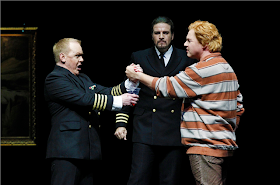Take for example the Guardian's ongoing series in its "culture" section that describes Tannhauser as, "An early opera that has corking tunes and a very silly plot. Staged with tongue firmly in the cheek, it can be magnificent" Or what about, "S is also for Siegfried, Siegmund and Sieglinde, key characters in the Ring and rather too intimately related for their own genetic good". Or perhaps, "Some have argued that Wagner's villains (sic)– Beckmesser in Meistersinger, Alberich and Mime in the Ring – are representations of Jewishness (Ed:One assumes they mean negative Jewish stereotypes?). The contention is hard to prove either way, which is fortunate for Wagnerians or these works would truly be tainted" (As tainted as Dicken's Oliver? Or Shakespeare's Merchant of Venice? Or George Orwell? Or Winston Churchill? Or ...). But lets not single out the Guardian. Lets look at the following from the Telegraph, "Vegetable lover: (Wagner) became convinced that eating meat instead of vegetables corrupted the blood, and refuse (sic)to touch meat again". Or what about the Independant which said...Oh! Hang on! Sorry, I forgot they fired most of their arts critics so the Sindy isn't saying much about Wagner at all nowadays. I could go on, but I think you get the picture.
Award winning publication, and Australia's only classical music magazine, faces an uncertain future.
Limelight magazine is currently under threat of closure after its publisher Haymarket Media has chosen to wind up its operations in Australia.Limelight is now in search of a buyer to take over the award-winning classical music magazine and website.
The decision came after Haymarket Media announced that they would cease to publish in Australia and were selling or licensing their brands to local publishers. Haymarket Media have been publishing Limelightmagazine under licence from the ABC since 2006.
“With the Haymarket Media Group (Ed: publisher of, believe it or not, Windpower Monthly ) internationally focusing on its chosen sectors, and the recent expansion in Singapore, we saw this as an ideal time for our Australian brands to go to local publishers that will invest to ensure their long-term future," said Jeremy Vaughan, Haymarket Media’s Managing Director.
Liz White, GM ABC Publishing said, “Winning Relaunch of the year 2012 and Consumer Magazine of the year 2013 (under 20,000 circ) at the Publishers Australia Excellence Awards was an endorsement from the magazine industry of the Limelight team’s achievements.”
Haymarket Media is still soliciting expressions of interest in Limelight until it closes its Australia offices on December 13.
With this in mind it should perhaps come as little surprise, that Australia's only classical music magazine, Limelight, maybe joining the cultural wasteland that the "western world" continues to produce at an alarming rate. Perhaps this would not be the case if Limlight had dedicated its "art" features to BoyZone? Or maybe it should have described "Der fliegende Holländer" as, "A rip roaring pirate adventure, as written by Barbara Cartland, in which: boy meets girl, boy wins girl, boy loses girl, boy gets girl back and they live happily ever after. It has scary ghosts too!" (Copyright: "The Wagnerian) See, I know how to do it. Official announcement below:
Award winning publication, and Australia's only classical music magazine, faces an uncertain future.
Limelight magazine is currently under threat of closure after its publisher Haymarket Media has chosen to wind up its operations in Australia.Limelight is now in search of a buyer to take over the award-winning classical music magazine and website.
The decision came after Haymarket Media announced that they would cease to publish in Australia and were selling or licensing their brands to local publishers. Haymarket Media have been publishing Limelightmagazine under licence from the ABC since 2006.
“With the Haymarket Media Group (Ed: publisher of, believe it or not, Windpower Monthly ) internationally focusing on its chosen sectors, and the recent expansion in Singapore, we saw this as an ideal time for our Australian brands to go to local publishers that will invest to ensure their long-term future," said Jeremy Vaughan, Haymarket Media’s Managing Director.
Liz White, GM ABC Publishing said, “Winning Relaunch of the year 2012 and Consumer Magazine of the year 2013 (under 20,000 circ) at the Publishers Australia Excellence Awards was an endorsement from the magazine industry of the Limelight team’s achievements.”
Haymarket Media is still soliciting expressions of interest in Limelight until it closes its Australia offices on December 13.




































